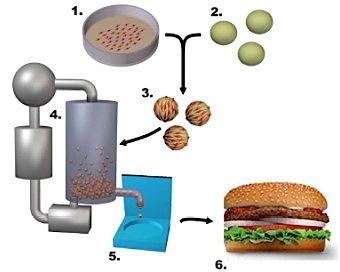Does the meat you eat have to have feet? Raised in vitro, they’re unnecessary.
Growing meat in the lab seems the stuff of
science fiction, but reality is not far behind.

Winston Churchill, a carnivore to the core, saw the
future of meat back in 1936. “Fifty years hence,” he wrote,
“we shall escape the absurdity of growing a whole chicken in order to eat
the breast or wing, by growing these parts separately under a suitable
medium.”
Churchill’s timing was out by at least three decades, but his prediction is steadily moving closer to reality. While governments chew over the science of meat production — from the US Food and Drug Administration’s recent backing for the consumption of meat and milk from cloned animals to this week’s revelation of a calf born to a cloned cow in Shropshire — scientists are now working feverishly on a third solution.
Meat that has never been part of an entire living animal is potentially far cleaner and healthier. Free from growth hormones and antibiotics, cultured meat could be made healthier by removing the harmful fats and introducing “good” fats such as omega-3.
The world consumes 240 billion kilos of meat each year. But more than 75 per cent of what is fed to an animal is lost through metabolism or inedible parts such as bones. In theory, with cultured meat, nothing is wasted, nothing suffers and nothing dies.
“Would humans be prepared to eat a meat that had never breathed?” — is the final question in the article. I think that is absurd — but, I am confident that all the flavors of Luddite, self-conscious or not, will fight to obstruct the choice, regardless of technology, taste or nutrition.
Churchill’s timing was out by at least three decades, but his prediction is steadily moving closer to reality. While governments chew over the science of meat production — from the US Food and Drug Administration’s recent backing for the consumption of meat and milk from cloned animals to this week’s revelation of a calf born to a cloned cow in Shropshire — scientists are now working feverishly on a third solution.
Meat that has never been part of an entire living animal is potentially far cleaner and healthier. Free from growth hormones and antibiotics, cultured meat could be made healthier by removing the harmful fats and introducing “good” fats such as omega-3.
The world consumes 240 billion kilos of meat each year. But more than 75 per cent of what is fed to an animal is lost through metabolism or inedible parts such as bones. In theory, with cultured meat, nothing is wasted, nothing suffers and nothing dies.
“Would humans be prepared to eat a meat that had never breathed?” — is the final question in the article. I think that is absurd — but, I am confident that all the flavors of Luddite, self-conscious or not, will fight to obstruct the choice, regardless of technology, taste or nutrition.
Posted: Sat - January 13, 2007 at 11:55 AM